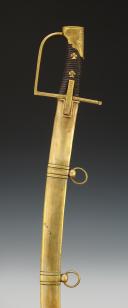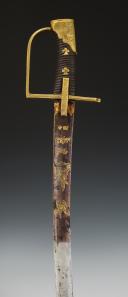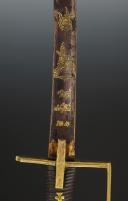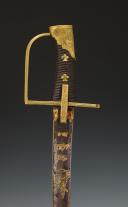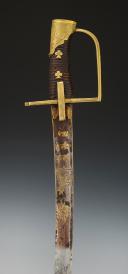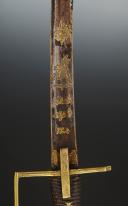
OFFICER'S SABER OF THE 4th REGIMENT OF HUSSARS, First Empire. 25840
Sold out
OFFICER'S SABER OF THE 4th HUSSAR REGIMENT, First Empire. 25840
Brass hilt. German style guard with engraved ears of wheat. Guard branch engraved with a laurel branch. Short-tailed cap with pommel engraved with a military trophy and cap with acanthus leaves. Handle in wood covered in original black waxed calf leather without original filigree with clover-shaped brass studs. Curved blade with hollow edges, length 86.5 cm, engraved and gilded on its first third with military trophies, foliage, a hussar on horseback, and the motto "Vivat / Hussar / n° 4", on a blued background, heel marked "V° A K / & F". Brass scabbard with two brass suspension ring brackets framed by a protruding molding.
France.
First Empire.
In good condition, the calf handle has slightly shrunk. Blade has retained its colors, slightly oxidized. The scabbard is not the model usually encountered on the saber of this regiment, however, this type of model appears at the end of the reign of Louis XVI, and was worn until the early years of the Restoration. The wear of the saber explains a slight shortening of the blade and the replacement of the original scabbard.
NOTE:
This specimen has a quillon ending in a hollow cut and not the usual button, it is part of an order of less than 400 units placed at the Versailles Manufacture for troop sabers, but we find this characteristic on this officer's saber.
In his reference work "Hussar Sabers from Louis XIV to the Present Day," Michel Pétard writes regarding this manufacturing "THE SPECIAL MODEL OF THE COLONEL-GENERAL REGIMENT, KNOWN AS 1780:
This regiment, created on August 22, 1779, but organized three years later on July 31, 1783, was formed from one squadron taken from each of the four existing regiments.
Instituted by Louis XVI for the benefit of the Duke of Chartres who would become the Duke of Orléans in 1785, this position of Colonel General of Hussars implied the creation of a regiment under this title and the official recognition of the hussar unit.
In 1783, a distinctive uniform was assigned to the new regiment as well as a kind of saber with special characteristics that deliberately stood out from the general hussar armament. Although no archive document informs us about its origin, the model specimen was preserved thanks to Gribeauval's initiative to create an artillery museum for the training of officer cadets, which reserved every model made in Klingenthal for this purpose. This model, of which we know of rare specimens, left a trace in the form of a supplementary order placed by the regiment dated December 1786 and of which 321 units were delivered between September 16, 1786, and May 23, 1787."
HISTORICAL:
The Colonel-General Hussars regiment is a French cavalry regiment of the Ancien Régime created in 1779 and became during the Revolution the 4th Hussar Regiment.
Creation and various denominations:
August 22, 1779: creation of the Colonel-General of Hussars position.
July 31, 1783: formation of the Colonel-General Hussars regiment by the merger of the 1st squadron of Berchény, the 2nd squadron of Chamborant, and the 3rd squadron of Esterhazy.
March 17, 1788: reinforced by a 4th squadron composed of men chosen from the cavalry regiments of Quercy, Septimania, Nassau, La Marche, Franche-Comté, and the Bishoprics.
January 1, 1791: renamed 5th Hussar Regiment.
June 4, 1793: renamed 4th Hussar Regiment.
1814: renamed the Hussars of Monsieur regiment.
1815: renamed 4th Hussar Regiment.
1815: disbanded.
Campaigns and battles:
The 5th Hussar Regiment, then the 4th Hussar Regiment following the emigration of the Saxe Hussars regiment on May 4, 1792, participated in campaigns from 1792 to 1794 in the Army of the North.
The 4th Hussar Regiment participated in campaigns from Year IV to Year V in the Army of Sambre-et-Meuse; Year VI in the armies of Germany and Mainz; Year VII in the armies of Mainz and the Danube; Years VIII and IX in the Army of the Rhine. Feats of Arms: Battle of Neuwield on April 18, 1797; Battle of Stockach on March 25, 1797; crossing of the Alb, Battle of Hochstedt and crossing of the Danube on April 29, June 19, and June 22, 1800.
It participated in campaigns from Year XI to Year XIV in Hanover; 1806 and 1807 in the 1st corps of the Grande Armée; from 1809 to 1810 in the Army of Spain; 1811 in the armies of Spain and Aragon; 1812 in the Army of Aragon and the 3rd corps of the Grande Armée; 1814 in the Army of Lyon (6th corps of the Grande Armée); 1815 in the 7th army corps.
Upon the first Restoration, the 4th Hussar Regiment had taken the title of the Regiment of Monsieur's Hussars and had received in its ranks the remnants of the 14th Hussar Regiment.
Brass hilt. German style guard with engraved ears of wheat. Guard branch engraved with a laurel branch. Short-tailed cap with pommel engraved with a military trophy and cap with acanthus leaves. Handle in wood covered in original black waxed calf leather without original filigree with clover-shaped brass studs. Curved blade with hollow edges, length 86.5 cm, engraved and gilded on its first third with military trophies, foliage, a hussar on horseback, and the motto "Vivat / Hussar / n° 4", on a blued background, heel marked "V° A K / & F". Brass scabbard with two brass suspension ring brackets framed by a protruding molding.
France.
First Empire.
In good condition, the calf handle has slightly shrunk. Blade has retained its colors, slightly oxidized. The scabbard is not the model usually encountered on the saber of this regiment, however, this type of model appears at the end of the reign of Louis XVI, and was worn until the early years of the Restoration. The wear of the saber explains a slight shortening of the blade and the replacement of the original scabbard.
NOTE:
This specimen has a quillon ending in a hollow cut and not the usual button, it is part of an order of less than 400 units placed at the Versailles Manufacture for troop sabers, but we find this characteristic on this officer's saber.
In his reference work "Hussar Sabers from Louis XIV to the Present Day," Michel Pétard writes regarding this manufacturing "THE SPECIAL MODEL OF THE COLONEL-GENERAL REGIMENT, KNOWN AS 1780:
This regiment, created on August 22, 1779, but organized three years later on July 31, 1783, was formed from one squadron taken from each of the four existing regiments.
Instituted by Louis XVI for the benefit of the Duke of Chartres who would become the Duke of Orléans in 1785, this position of Colonel General of Hussars implied the creation of a regiment under this title and the official recognition of the hussar unit.
In 1783, a distinctive uniform was assigned to the new regiment as well as a kind of saber with special characteristics that deliberately stood out from the general hussar armament. Although no archive document informs us about its origin, the model specimen was preserved thanks to Gribeauval's initiative to create an artillery museum for the training of officer cadets, which reserved every model made in Klingenthal for this purpose. This model, of which we know of rare specimens, left a trace in the form of a supplementary order placed by the regiment dated December 1786 and of which 321 units were delivered between September 16, 1786, and May 23, 1787."
HISTORICAL:
The Colonel-General Hussars regiment is a French cavalry regiment of the Ancien Régime created in 1779 and became during the Revolution the 4th Hussar Regiment.
Creation and various denominations:
August 22, 1779: creation of the Colonel-General of Hussars position.
July 31, 1783: formation of the Colonel-General Hussars regiment by the merger of the 1st squadron of Berchény, the 2nd squadron of Chamborant, and the 3rd squadron of Esterhazy.
March 17, 1788: reinforced by a 4th squadron composed of men chosen from the cavalry regiments of Quercy, Septimania, Nassau, La Marche, Franche-Comté, and the Bishoprics.
January 1, 1791: renamed 5th Hussar Regiment.
June 4, 1793: renamed 4th Hussar Regiment.
1814: renamed the Hussars of Monsieur regiment.
1815: renamed 4th Hussar Regiment.
1815: disbanded.
Campaigns and battles:
The 5th Hussar Regiment, then the 4th Hussar Regiment following the emigration of the Saxe Hussars regiment on May 4, 1792, participated in campaigns from 1792 to 1794 in the Army of the North.
The 4th Hussar Regiment participated in campaigns from Year IV to Year V in the Army of Sambre-et-Meuse; Year VI in the armies of Germany and Mainz; Year VII in the armies of Mainz and the Danube; Years VIII and IX in the Army of the Rhine. Feats of Arms: Battle of Neuwield on April 18, 1797; Battle of Stockach on March 25, 1797; crossing of the Alb, Battle of Hochstedt and crossing of the Danube on April 29, June 19, and June 22, 1800.
It participated in campaigns from Year XI to Year XIV in Hanover; 1806 and 1807 in the 1st corps of the Grande Armée; from 1809 to 1810 in the Army of Spain; 1811 in the armies of Spain and Aragon; 1812 in the Army of Aragon and the 3rd corps of the Grande Armée; 1814 in the Army of Lyon (6th corps of the Grande Armée); 1815 in the 7th army corps.
Upon the first Restoration, the 4th Hussar Regiment had taken the title of the Regiment of Monsieur's Hussars and had received in its ranks the remnants of the 14th Hussar Regiment.
Reference :
25840
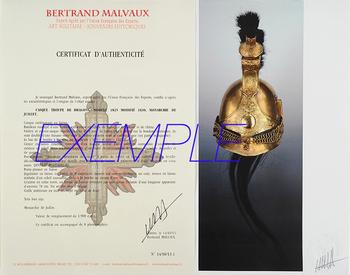
Next update Friday, april 4th at 1:30 PM
FOR ALL PURCHASES, PAYMENT IN MULTIPLE CHECKS POSSIBLE
bertrand.malvaux@wanadoo.fr 06 07 75 74 63
An authenticity certificate of the item including the description published on the site, the period, the sale price, accompanied by one or more color photographs is automatically provided for any item priced over 130 euros. Below this price, each certificate is charged 5 euros.
Only items sold by me are subject to an authenticity certificate, I do not provide any expert reports for items sold by third parties (colleagues or collectors).
